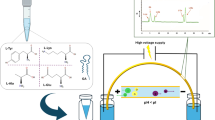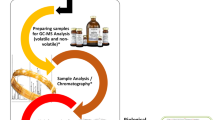Abstract
Arsenic speciation is a subject that is developing all the time both from improvements in analytical techniques and from increases in toxicological understanding. Despite speciation methods being widely developed, arsenic speciation is not routinely offered as an analysis in clinical laboratory. The work in this paper describes a simple routine method for arsenic speciation that could be easily implemented in clinical laboratories. The method described, a new, fast analytical method for arsenic speciation, is reported using micro-liquid chromatography hyphenated to an inductively coupled plasma mass spectrometer (μLC-ICP-MS). The method uses a low-pressure delivery six-port valve with a 5 cm anion exchange column, which allows a fully resolved separation of five arsenic species (arsenobetaine [AB], arsenite [As3+], arsenate [As5+], mono-methylarsonic acid [MMA5+] and dimethylarsinic acid [DMA5+]) in urine in just 6 min. This fast analytical method offers an arsenic speciation method that is feasible for a laboratory that does not have the capability for a dedicated arsenic speciation LC-ICP-MS instrument. The micro-LC system is small, easy to install and is fully integrated with the ICP-MS software. The results reported here are from urine samples from 65 workers in a semiconductor work providing a sample for their routine biological monitoring to assess workplace exposure. Control samples from 20 unexposed people were also determined. Results show that the semiconductor workers exhibit very low levels of arsenic in their urine samples, similar to the levels in the controls, and thus are not significantly exposed to arsenic. Care must be taken when interpreting urinary arsenic species results because it is not always possible to differentiate between dietary and other external sources of exposure.


Similar content being viewed by others
References
IARC (1998). http://monographs.iarc.fr/ENG/Monographs/vol2/volume2.pdf
ATSDR (2007) Toxicological profile for arsenic, 2007. U.S. Department of Health and Human Services, Centers for Disease Control and Prevention, Agency for Toxic Substances and Disease Registry. Atlanta, (GA). http://www.atsdr.cdc.gov/toxprofiles/tp2.html, accessed 25/06/2010
Nachman KE, Graham JP, Price LB, Silbergeld EK (2005) Arsenic: a roadblock to potential animal waste management solutions. Environ Health Perspect 113:1123–1124
Ouypornkochagorn S, Feldmann J (2010) Dermal uptake of arsenic through human skin depends strongly on its speciation. Environ Sci Technol 44:3972–3978
Cleland B, Tschiya A, Kalman DA, Dills R, Burbacher TM, White JW, Faustman EM, Mariën K (2009) Arsenic exposure within the Korean Community (United States) based on dietary behaviour and arsenic levels in hair, urine, air and water. Environ Health Perspect 117:632–638
EFSA Panel on Contaminants in the Food Chain (CONTAM). Scientific opinion on arsenic. http://www.efsa.europa.eu/en/contamtopics/topic/metals.htm, accessed on 30/06/10
Pinel-Raffaitin P, Le Hecho I, Amouroux D, Potin-Gautier M (2007) Distribution and fate of inorganic and organic arsenic species in landfill leachates and biogases. Environ Sci Technol 41:4536–4541
Meharg AA, Raab A (2010) Getting to the bottom of arsenic standards and guidelines. Environ Sci Technol 44:4395–4399
Raml RW, Goessler W, Francesconi KA (2006) Improved chromatographic separation of thio-arsenic compounds by reversed-phase high performance liquid chromatography–inductively coupled plasma mass spectrometry. J Chromatogr A 1128:164–170
Raber G, Raml R, Goessler W, Francesconi KA (2010) Quantitative speciation of arsenic compounds when using organic solvent gradients in HPLC-ICPMS. J Anal At Spectrom 25:570–576
National Reseacrh Council (NRC) (2001) Arsenic in drinking water—2001 update. National Academy Press, Washington
Caldwell KL, Jones RL, Verdon CP, Jarrett JM, Caudill SP, Osterloh JD (2009) Levels of urinary total and speciated arsenic in the US population: National Health and Nutrition Examination Survey 2003–2004. J Expo Sci Environ Epidemiol 19:59–68
Valenzuela OL, Borja-Arbuto VH, Garcia-Vargas GG, Cruz-Gonzalez MB, Garcia-Montalvo EA, Calderon-Aranda ES, Del Razo LM (2005) Urinary trivalent methylated arsenic species in a population chronically exposed to inorganic arsenic. Environ Health Perspect 113:250–254
Mandal BK, Suzuki K, Anzai K (2007) Impact of arsenic in foodstuffs on the people living in the arsenic-affected areas of West Bengal, India. J Environ Sci Health A 42:1741–1752
Mandal BK, Ogra Y, Suzuki KT (2001) Identification of dimethylarsinous and monmethylarsonous acids in human urine of arsenic-affected areas in West Bengal, India. Chem Res Toxicol 14:371–378
Styblo M, Del Razo LM, Vega L, Germolec DR, LeCluyse EL, Hamilton GA, Reed W, Wang C, Cullen WR, Thomas DJ (2000) Comparative toxicity of trivalent and pentavalent inorganic and methylated arsenicals in rat and human cells. Arch Toxicol 74:289–299
Petrick JS, Jagadish B, Mash EA, Aposhian HV (2001) Monomethylarsonous acid (MMA(III)) and arsenite: LD(50) in hamsters and in vitro inhibition of pyruvate dehydrogenase. Chem Res Toxicol 14:651–656
Francesconi K, Kuehnelt D (2004) Determination of arsenic species: a critical review of methods and applications, 2000–2003. Analyst 129:373–395
Šlejkovec Z, Falnoga I, Goessler W, van Elteren JT, Raml R, Podgornik H, Černelč P (2008) Analytical artefacts in the speciation of arsenic in clinical samples. Anal Chim Acta 607:83–91
Newcombe C, Raab A, Williams PN, Deacon C, Haris PI, Meharg AA, Feldmann J (2010) Accumulation or production of arsenobetaine in humans? J Environ Monitoring. 12:832–837
Gailer J, Francesconi KA, Edmonds JS, Irgolic KJ (1995) Metabolism of arsenic compounds by the blue mussel Mytilus edulis after accumulation from seawater spiked with arsenic compounds. Appl Organomet Chem 9:341–345
Otto D, Xia Y, Li Y, Wu K, He L, Telech J, Hundell H, Prah J, Mumford J, Wade T (2007) Neurosensory effects of chronic human exposure to arsenic associated with body burden and environmental measures. Human Exp Toxicol 26:169–177
Watts MJ, Button M, Brewer TS, Jenkin GRT, Harrington CF (2008) Quantitative arsenic speciation in two species of earthworms from a former mine site. J Environ Monit 10:753–759
Yuan C, Lu X, Oro N, Wang Z, Xia Y, Wade TJ, Le Mumford XC (2008) Arsenic speciation in saliva. Clin Chem 54:163–171
Kala SV, Kala G, Prater CI, Sartorelli AC, Leiberman MW (2004) Formation and urinary excretion of arsenic triglutathione and methylarsenic diglutathione. Chem Res Toxicol 17:243–249
Hernandez-Zavala A, Matousek T, Drobna Z, Paul DS, Walton F, Adair BM, Dedina J, Thomas DJ, Styblo M (2008) Speciation analysis of arsenic in biological matrices by automated hydride generation–cryotrapping–atomic absorption spectrometry with multiple microflame quartz atomizer (multiatomizer). J Anal At Spectrom 23:342–351
Steinmaus C, Bates MN, Yuan Y, Kalman D, Atallah R, Rey OA, Biggs ML, Hopenhayn C, Moore LE, Hoang BK, Smith AH (2006) Arsenic methylation and bladder cancer risk in case–control studies in Argentina and the United States. J Occup Enivron Med 48:478–488
Huang Y-K, Huang Y-L, Hsueh Y-M, Yang M-H, Wu M-M, Chen S-Y, Hsu L-I, Chen C-J (2008) Arsenic exposure, urinary arsenic speciation and the incidence of urothelial carcinoma: a twelve-year follow-up study. Cancer Causes Control 19:829–839
Vahter M, Concha G, Nermell B, Nilson R, Dultot F, Natarajan AT (1995) A unique metabolism of inorganic arsenic in Native Andean women. J Pharm Environ Toxicol Pharm Sect 293:455–462
Brima EI, Haris PI, Jenkins RO, Polya DA, Gault AG, Harrington CF (2006) Understanding arsenic metabolism through a comparative study of arsenic levels in urine, hair and fingernails of healthy volunteers from three unexposed ethnic groups in the United Kingdom. Toxicol Appl Pharmacol 216:122–130
Morton J, Mason H (2006) Speciation of arsenic compounds in urine from occupationally unexposed and exposed persons in the UK using a routine LC-ICP-MS method. J Anal Toxicol 30:293–301
Heitland P, Köster HD (2008) Fast determination of arsenic species and total arsenic in urine by HPLC-ICP-MS: concentration ranges for unexposed German inhabitants and clinical case studies. J Anal Toxicol 32:308–314
HSE (1997) HSG 167 Biological monitoring in the workplace. http://www.hse.gov.uk/pubns/books/hsg167.htm
Hata A, Endo Y, Nakajima Y, Ikebe M, Ogawa M, Fujitani N, Endo G (2007) HPLC-ICP-MS speciation analysis of arsenic in urine of Japanese subjects without occupational exposure. J Occup Health 49:217–223
Soleo L, Lovreglio P, Iavicoli S, Antelmi A, Drago I, Basso A, Di Lorenzo L, Gilberti ME, De Palma G, Apostoli P (2008) Significance of urinary arsenic speciation in assessment of seafood ingestion as the main source of organic and inorganic arsenic is a populations resident near a coastal area. Chemosphere 73:291–299
ACGIH (2010) TLVs and BEIs for chemical substances. Signature Publications, USA. www.acgih.org
DFG German DFG Deutsche Forschungsgemeinschaft (2009) List of MAK and BAT values 2009. Wiley-VCH, Germany
Suzuki Y, Shimodo Y, Endo Y, Hata A, Yamanaka K, Endo G (2009) Rapid and effective speciation analysis of arsenic compounds in human urine using anion-exchange columns in HPLC-ICP-MS. J Occup Health 51:380–385
Williams PN, Price AH, Raab A, Hossain SA, Feldmann J, Meharg AA (2005) Variation in arsenic speciation and concentration in paddy rice related to dietary exposure. Environ Sci Technol 39:5531–5540
Acknowledgements
The authors would like to thank Dr. Paul Watson from ESI Scientific and Dr. Simon Nelms from Thermo Fisher Scientific for their help with the One-Fast system.
Author information
Authors and Affiliations
Corresponding author
Additional information
Published in the special issue Speciation Analysis in Healthcare with Guest Editor Heidi Goenaga Infante.
Rights and permissions
About this article
Cite this article
Morton, J., Leese, E. Arsenic speciation in clinical samples: urine analysis using fast micro-liquid chromatography ICP-MS. Anal Bioanal Chem 399, 1781–1788 (2011). https://doi.org/10.1007/s00216-010-4180-z
Received:
Revised:
Accepted:
Published:
Issue Date:
DOI: https://doi.org/10.1007/s00216-010-4180-z




